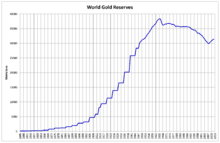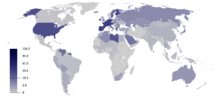Gold reserve
| Public finance |
|---|
 |
|
Reform |





A gold reserve is the gold held by a national central bank, intended as a store of value and as a guarantee to redeem promises to pay depositors, note holders (e.g. paper money), or trading peers, or to secure a currency.
It has been estimated that all the gold mined by the end of 2011 totaled 171,300 tonnes.[1] At a price of US$1,500 per troy ounce, reached on 12 April 2013, one tonne of gold has a value of approximately US$48.2 million. The total value of all gold ever mined would exceed US$8.2 trillion at that valuation.[note 1]
However, there are varying estimates of the total amount of gold mined to date, mainly because gold has been mined for thousands of years around the world. Another reason is that some countries are not particularly open about how much gold they are mining. In addition, it is difficult to account for gold output in illegal mining activities.[2]
Wartime relevance
During most of history, a nation's gold reserves were considered its key financial asset and a major prize of war. A typical view was expressed in a secret memorandum by the British Chief of the Imperial General Staff from October 1939, at the beginning of World War II. The British Military and the British Secret Service laid out "measures to be taken in the event of an invasion of Holland and Belgium by Germany" and presented them to the War Cabinet:
It will be for the Treasury in collaboration with the Bank of England, and the Foreign Office, to examine the possible means of getting the bullion and negotiable securities into the same place of safety. The transport of many hundreds of tons of bullion presents a difficult problem and the loading would take a long time. The ideal would of course be to have the gold transferred to this country or to the United States of America. [...] The gold reserves of Belgium and Holland amount to about £70 million and £110 million respectively. [Foot]Note: H. M. Treasury has particularly requested that this information, which is highly confidential should in no circumstances be divulged. The total weight of this bullion amounts to about 1800 tons and its evacuation would be a matter of the utmost importance would present a considerable problem if it had to be undertaken in a hurry when transport facilities were disorganized. At present this gold is believed to be stored at Brussels and The Hague respectively, neither of which is very well placed for its rapid evacuation in an emergency.[3]
The Belgian government rushed to ship the gold to a safe place: Dakar, the capital of Senegal, then part of the French colonial empire. After the Germans occupied Belgium and France in 1940, they demanded the Belgian gold reserve back. In 1941, Vichy French officials arranged the transport of 4,944 boxes with 198 tons of gold to officials of the German Reichsbank.[4]
IMF holdings
Since early 2011, the gold holdings of the IMF have been constant at 90.5 million troy ounces (2,814.1 metric tons).[5]
Officially reported holdings
The IMF regularly maintains statistics of national assets as reported by various countries.[6] These data are used by the World Gold Council to periodically rank and report the gold holdings of countries and official organizations.
On 17 July 2015, China announced that it increased its gold reserves by about 57 percent from 1,054 to 1,658 metric tons, while disclosing its official gold reserves for the first time in six years.[7][8]
The gold listed for each of the countries in the table may not be physically stored in the country listed, as central banks generally have not allowed independent audits of their reserves. Gold leasing by central banks could place into doubt the reported gold holdings in the table below.[9]
| Rank | Country/Organization | Gold holdings (in tonnes) |
Gold's share of forex reserves |
|---|---|---|---|
| 1 | | 8,133.5 | 76% |
| 2 | | 3,377.9 | 70% |
| 3 | International Monetary Fund | 2,814.0 | N.A. |
| 4 | | 2,451.8 | 69% |
| 5 | | 2,435.8 | 65% |
| 6 | | 1,838.5 | 2% |
| 7 | | 1,542.7 | 16% |
| 8 | | 1,040.0 | 6% |
| 9 | | 765.2 | 3% |
| 10 | | 612.5 | 65% |
| 11 | | 557.8 | 6% |
| 12 | | 504.8 | 28% |
| 13 | | 442.1 | 16% |
| 14 | | 423.6 | 4% |
| 15 | | 382.5 | 62% |
| 16 | | 322.9 | 2% |
| 17 | | 310.3 | 9% |
| 18 | | 286.8 | 24% |
| 19 | | 281.6 | 18% |
| 20 | | 280.0 | 45% |
| 21 | | 248.2 | 34% |
| 22 | | 227.4 | 38% |
| 23 | | 196.2 | 10% |
| 24 | | 188.8 | 64% |
| 25 | | 173.6 | 5% |
| 26 | | 152.4 | 4% |
| 27 | | 127.4 | 2% |
| 28 | | 125.7 | 9% |
| 29 | | 125.3 | 11% |
| 30 | | 120.9 | 3% |
| 31 | | 116.6 | 6% |
| 32 | | 112.7 | 63% |
| 33 | | 104.4 | 1% |
| 34 | Bank for International Settlements | 104.0 | N.A. |
| 35 | | 103.7 | 11% |
| 36 | | 102.9 | 4% |
| 37 | | 89.8 | 7% |
| 38 | | 79.9 | 7% |
| 39 | | 79.0 | 10% |
| 40 | | 78.1 | 3% |
| - | Total for the Top 40 | 31,461.3 |
Private holdings
| Rank | Name | Type | Gold holdings (in tonnes) |
|---|---|---|---|
| 1 | SPDR Gold Shares | ETF | 672.7[16] |
| 2 | ETF Securities Gold Funds | ETF | 215.2[15] |
| 3 | COMEX Gold Trust | ETF | 164.7[15] |
| 4 | ZKB Physical Gold | ETF | 138.7[15] |
| 5 | Central Fund of Canada | CEF | 52.7[17] |
| 6 | Julius Baer Physical Gold Fund | ETF | 49.1[15] |
| 7 | Sprott Physical Gold Trust | CEF | 38.6[18] |
| 8 | BullionVault | Bailment | 34.2[19] |
| 9 | ABSA NewGold Exchange Traded Fund | ETF | 26.6[20] |
| 10 | ETFS Physical Swiss Gold Shares | ETF | 23.4[21] |
| 11 | Central GoldTrust | CEF | 21.9[22] |
| 12 | GoldMoney | Bailment | 19.4[23] |
| - | Total for the above 12 | 1,457.2 |
World holdings
| Location | Gold holdings (in tonnes) |
Share of total world gold holdings |
|---|---|---|
| Total | 171,300 | 100% |
| Jewellery | 84,300 | 49.2% |
| Investment (bars, coins) | 33,000 | 19.26% |
| Central banks | 29,500 | 17.2% |
| Industrial | 20,800 | 12.14% |
| Unaccounted | 3,700 | 2.2% |
See also
- Federal Reserve Bank of New York
- Gold as an investment
- Gold repatriation
- Gold reserves of Norway
- Gold standard
- List of countries by gold production
- Moscow gold, the reserves of the Bank of Spain sent to the Soviet Union during the Spanish Civil War
- Romanian Treasure, the Romanian gold reserves sent (alongside other valuable objects) to Russia for safekeeping during World War I, but never returned
- Peak gold
- Silver as an investment
- Strategic Petroleum Reserve (United States)
- United States Bullion Depository, often known as Fort Knox
- Vaulted gold
Notes
- ↑ One tonne is equal to approximately 32,150.75 troy ounces.
{ gold, silver, & other precious metals & gems are weighed by the troy ounce, 12 troy ounces = 1 pound not 16 to 1 in most other normal weights, so there would be 24,000 troy ounces to a ton of weight }
References
- 1 2 on page 2 of the pdf file; last paragraph just before the "Production" section on that page
- ↑ Prior, Ed (2013-04-01). "How much gold is there in the world?". BBC News. Retrieved 2016-10-28.
- ↑ Memorandum by War Cabinet Secretary E. E. Bridges from October 6, 1939, Secret: Holland and Belgium: Measures to be taken in the event of an invasion by Germany. P. 1 and 4. The National Archives (United Kingdom)
- ↑ "Belgian gold in foreign hands". Museum of the National Bank of Belgium. 4 March 2010. Retrieved 19 January 2016.
- ↑ "Gold in the IMF". International Monetary Fund. Archived from the original on April 22, 2011.
- ↑ "Data Template on International Reserves and Foreign Currency Liquidity -- Reporting Countries".
- ↑ "Gold & Foreign Exchange Reserves".
- ↑ "Major Factors Affecting Gold Prices Fluctuation". FXdailyReport.Com. 2016-07-22. Retrieved 2016-10-28.
- ↑ "- Sprott Global Resource Investments Ltd.".
- ↑ "Research - World Gold Council".
- ↑ "Latest World Official Gold Reserves - World Gold Council".
- ↑ "Gold Demand Trends - World Gold Council".
- ↑ "Top 40 reported official gold holdings (as at September 2016)" is on the 7th page of the pdf file.
- ↑ Gold has been added to Turkey's balance sheet as a result of a policy accepting gold in its reserve requirements from commercial banks.
- 1 2 3 4 5 "CORRECTED-TABLE-Holdings of SPDR Gold, iShares Silver unchanged (March 30)". Reuters. 2 July 2015. Archived from the original on August 1, 2015. Retrieved 1 August 2015.
- ↑ "Total Gold in Trust". SPDR Gold Shares. 31 July 2015. Retrieved 1 August 2015.
- ↑ "Central Fund's Net Asset Value". Central Fund of Canada. 31 July 2015. Archived from the original on August 1, 2015. Retrieved 1 August 2015.
- ↑ "Net Asset Value - Sprott Physical Gold Trust - Sprott Physical Bullion Trusts". Sprott Asset Management. 31 July 2015. Archived from the original on August 1, 2015. Retrieved 1 August 2015.
- ↑ "Daily audit - Allocated gold bar lists and bank statements". BullionVault. 31 July 2015. Retrieved 1 August 2015.
- ↑ "NewGold Exchange Traded Fund". Absa Group. 31 July 2015. Archived from the original on August 1, 2015. Retrieved 1 August 2015.
- ↑ "ETFS Physical Swiss Gold Shares". ETF Securities. 31 July 2015. Retrieved 1 August 2015.
- ↑ "GoldTrust's Net Asset Value". Central GoldTrust. 31 July 2015. Archived from the original on August 1, 2015. Retrieved 1 August 2015.
- ↑ "Monthly Total Value Report". GoldMoney. 31 July 2015. Archived from the original on August 1, 2015. Retrieved 1 August 2015.
- ↑ "Two Methods for Estimating the Price of Gold by Mike Hewitt". DollarDaze Economic Commentary Blog - Gold, Oil, Stocks, Investments, Currencies, and the Federal Reserve. Retrieved 2012-01-08.